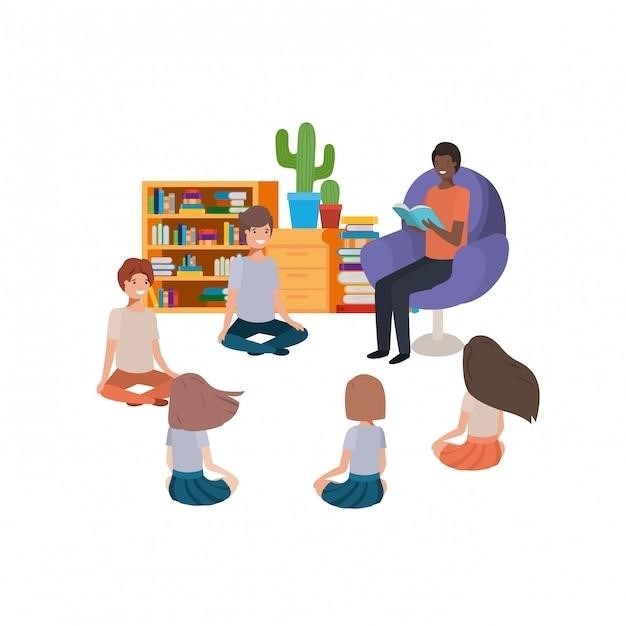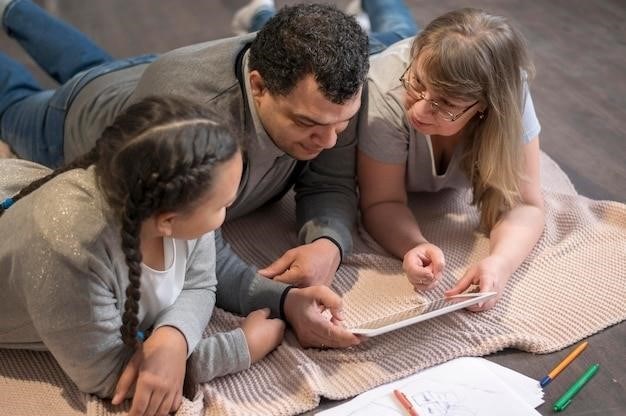Guided Reading Activity 16-4⁚ A Comprehensive Overview
Guided Reading Activity 16-4 is a valuable tool for educators to enhance student comprehension and engagement in the learning process. It is designed to help students develop essential reading skills and deepen their understanding of key concepts and facts. This activity serves as a structured approach to reading instruction, providing a supportive environment for students to explore and analyze texts at their own pace.
The Importance of Guided Reading
Guided reading is a cornerstone of effective literacy instruction, playing a crucial role in fostering a love of reading and developing essential reading skills. It provides a structured and supportive environment where students can engage with texts at their individual reading levels, receiving personalized support from the teacher. Guided reading is not merely about decoding words but about developing comprehension, fluency, and a deep understanding of the text. By providing targeted instruction and opportunities for interaction, guided reading empowers students to become confident and independent readers.
The benefits of guided reading extend beyond individual reading skills. It promotes critical thinking, vocabulary development, and the ability to make connections between texts and the real world. Guided reading sessions create a sense of community in the classroom, fostering a love of learning and encouraging students to share their thoughts and ideas. In a world increasingly reliant on literacy, guided reading lays a solid foundation for lifelong learning and success.
Understanding Guided Reading Activity 16-4
Guided Reading Activity 16-4 is a specific activity designed to engage students in a deeper understanding of a particular topic. It often focuses on recalling key facts and information from a specific text or section of a textbook. This activity encourages students to think critically about what they have read and to apply their understanding to answer questions or complete tasks. It is a common practice in educational settings, particularly in subjects like social studies and history, where understanding factual information is essential.
Activity 16-4 may involve a variety of tasks, such as answering multiple-choice questions, filling in charts or diagrams, or writing short responses based on the text. The objective is to help students solidify their comprehension of the material and to ensure they can recall important details. This activity can be adapted to different reading levels and learning styles, making it a versatile tool for educators.
Key Concepts and Skills Addressed in Activity 16-4
Guided Reading Activity 16-4 aims to address a range of crucial reading and learning skills. It emphasizes the importance of recalling specific facts and information, a fundamental aspect of comprehension. Students are encouraged to identify key details, analyze the text for evidence, and synthesize the information they have gathered. This activity also reinforces the ability to organize thoughts and express them clearly in written form, whether through short answers, completing charts, or writing summaries.
Moreover, Activity 16-4 helps students develop critical thinking skills by encouraging them to evaluate the information presented and draw connections between different concepts. By prompting students to think about the “why” behind the facts, it promotes deeper understanding and encourages them to move beyond simply memorizing information. This activity is particularly valuable for building foundational reading skills that are essential for success in academic pursuits.
The Role of the Teacher in Guided Reading
The teacher plays a pivotal role in facilitating the Guided Reading experience. They act as a guide and facilitator, creating a supportive environment for students to explore the text and develop their reading skills. The teacher’s primary responsibility is to carefully select texts that are appropriate for the students’ reading levels, ensuring that the material is engaging and challenging but not overwhelming. They introduce the text by activating prior knowledge, setting a purpose for reading, and establishing clear expectations for student engagement.
During the reading process, the teacher observes students, providing support and scaffolding as needed. They may ask questions to check for comprehension, model strategies for decoding unknown words, and encourage students to make predictions and inferences. The teacher also facilitates discussions, helping students to share their understanding, make connections to other texts, and develop their critical thinking skills. By providing individualized support, the teacher helps each student make progress at their own pace, creating a positive and collaborative learning environment.
Effective Strategies for Implementing Guided Reading Activity 16-4
Successful implementation of Guided Reading Activity 16-4 requires a multifaceted approach that integrates various strategies to enhance student engagement and comprehension. One effective strategy is to use pre-reading activities to activate prior knowledge and set a purpose for reading. This could involve asking students to brainstorm ideas related to the topic, viewing images or videos, or discussing relevant vocabulary. During reading, teachers can employ think-aloud strategies to model their thinking processes, demonstrate effective reading strategies, and encourage students to participate in the process.
Another crucial element is incorporating post-reading activities to deepen understanding and reinforce learning. This could involve summarizing the text, answering comprehension questions, creating graphic organizers, or engaging in discussions about the main ideas and supporting details. Teachers can also integrate technology by using interactive whiteboards, online resources, or digital tools to enhance student engagement and provide visual aids. By incorporating these strategies, educators can create a dynamic and interactive learning environment that fosters student growth and success in Guided Reading.
Differentiation and Meeting Individual Needs
Guided Reading Activity 16-4 is designed to cater to a range of reading levels and learning styles, making it essential to implement differentiation strategies to meet individual student needs. One approach is to provide differentiated reading materials, selecting texts that align with each student’s reading level and interests. This could involve offering multiple versions of the same text at varying levels of complexity, providing graphic organizers or other support tools, or allowing students to choose from a variety of texts based on their preferences.
Another key aspect is to provide differentiated instruction during guided reading sessions. This could involve offering small group instruction tailored to specific learning needs, providing individualized support to students who require additional assistance, or creating challenging extension activities for students who are ready for more advanced learning. By implementing these strategies, teachers can create an inclusive learning environment that empowers all students to succeed in Guided Reading Activity 16-4.
Assessment and Monitoring Student Progress
Effective assessment is crucial for monitoring student progress in Guided Reading Activity 16-4. Teachers can employ a variety of assessment methods to gauge student understanding and identify areas that require further support. One approach is to conduct informal assessments during guided reading sessions, observing students’ reading fluency, comprehension, and participation in discussions.
Formal assessments can also be used to measure student progress over time. This might involve administering reading comprehension quizzes, analyzing student work samples, or conducting individual reading conferences. By analyzing assessment data, teachers can identify patterns in student performance, adjust instructional strategies, and provide targeted support to help students achieve their reading goals.
Resources and Materials for Guided Reading Activity 16-4
A variety of resources and materials can be used to support Guided Reading Activity 16-4, making it a dynamic and engaging experience for students. These resources can enhance comprehension, provide opportunities for practice, and facilitate differentiated instruction. Textbooks, workbooks, and supplemental reading materials are valuable tools for providing students with the necessary content and practice opportunities.
Technology can also play a significant role in enhancing guided reading. Interactive whiteboards, online reading platforms, and digital dictionaries can provide students with access to a wealth of information and support their learning. Moreover, visual aids such as posters, charts, and graphic organizers can help students visualize concepts, make connections, and organize their thoughts. By utilizing a diverse range of resources and materials, teachers can create a rich and engaging learning environment for Guided Reading Activity 16-4.

Connecting Guided Reading Activity 16-4 to Other Curriculum Areas
Guided Reading Activity 16-4 can seamlessly integrate with other curriculum areas, fostering a holistic learning experience. This integration creates meaningful connections and reinforces concepts across disciplines. For instance, if the activity focuses on historical events, it can be linked to social studies lessons, allowing students to delve deeper into the context and significance of those events. Similarly, if the reading material touches upon scientific concepts, it can be connected to science lessons, providing students with a more comprehensive understanding of the subject matter.
Furthermore, Guided Reading Activity 16-4 can be integrated with language arts lessons, encouraging students to analyze text structure, identify literary devices, and expand their vocabulary. This interconnected approach not only enhances student learning but also encourages them to view knowledge as a unified whole, rather than isolated compartments. By connecting Guided Reading Activity 16-4 to other curriculum areas, teachers can create a rich and engaging learning experience that promotes deeper understanding and fosters a love of learning.
Making Guided Reading Engaging and Meaningful
Making Guided Reading Activity 16-4 engaging and meaningful requires a blend of strategic planning and creative implementation. Teachers can leverage various techniques to captivate students’ attention and foster a genuine love for reading. One effective approach is to select texts that align with students’ interests, ensuring that the content is both relevant and stimulating. This can be achieved by incorporating a diverse range of genres, including fiction, nonfiction, poetry, and even graphic novels.
Furthermore, teachers can create a dynamic learning environment by incorporating interactive activities, such as role-playing, debates, and creative writing prompts. These activities encourage active participation, stimulate critical thinking, and foster a collaborative learning atmosphere. By engaging multiple senses and incorporating diverse learning styles, teachers can make Guided Reading Activity 16-4 a truly enriching and memorable experience for their students.
The Benefits of Guided Reading
Guided Reading Activity 16-4, when implemented effectively, offers a multitude of benefits for both students and teachers. By providing a structured framework for reading instruction, this activity empowers students to develop essential reading skills, enhance their comprehension abilities, and cultivate a love for reading. Teachers, in turn, gain valuable insights into their students’ reading levels, enabling them to tailor instruction to meet individual needs and provide targeted support.

Furthermore, Guided Reading Activity 16-4 fosters a collaborative learning environment, promoting active participation, critical thinking, and meaningful discussions among students. Through this activity, students develop a deeper understanding of the text, learn to connect ideas, and build upon their existing knowledge base. The benefits of Guided Reading Activity 16-4 extend beyond the classroom, equipping students with the skills necessary to become confident and independent readers throughout their academic journey and beyond.
